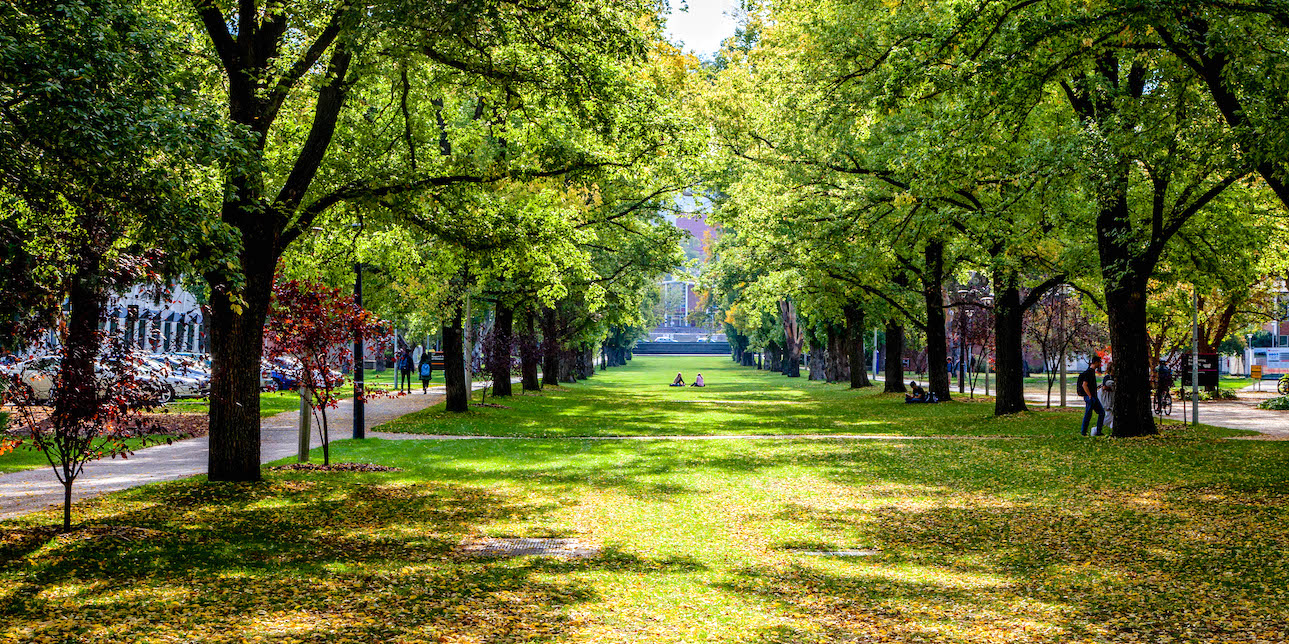Saturday’s good reading and listening for the weekend
May 15, 2021
What people in other forums are saying about public policy
The Budget
If “Australia’s economic engine is roaring back to life”, why does it need another three years of fiscal stimulus averaging 4.4 per cent of GDP? In fact it would need even more stimulus but for Chinese demand for iron ore.
The real state of the economy lies in the government’s economic forecasts, summarised in Budget Paper 1and reproduced in the table below.

In the coming year Treasury expects to see a 4.25 per cent in GDP growth, but that’s off a low base, before settling back to an anaemic 2.25 to 2.50 percentage growth – lower than the average GDP growth of 2.8 per cent over this century so far, before the pandemic hit.
The same table also reveals that Treasury expects there to be no growth in real wages until 2024-25 – in fact a fall in real wages in the short term. Only in 2024-25 does the wage price index creep above the CPI.
The economy isn’t “roaring back to life”: rather it is clawing its way back to mediocrity.
Most media have looked at the detail – “what’s in it for me” or what’s in it for aged care/mental health/small business/women – missing the overall picture. That’s the usual triumph for the incumbent government’s media manipulation in the budget lockup process. To have heard the ABC’s Fran Kelly and Alison Carabine on the morning after the budget one could believe that “everyone’s a winner” and that there were no ideological constraints in framing the budget. (7 minutes.)
The Australian economy is slowly heading back to its pre-pandemic performance with no wages growth and weak productivity growth. There is hardly any policy directed to addressing our country’s structural weaknesses – dependence on fossil fuel, an export base dominated by unprocessed commodities and by China as a customer, widening inequalities in wealth and opportunity, falling education standards relative to our competitors, and a dangerously inflating housing bubble.
Not only does the budget largely ignore these structural problems: in one important aspect it worsens them. It’s decision to underwrite some house purchasers with a deposit as little as 2 per cent, and to allow people to withdraw up to $50 000 from superannuation to buy houses, is not only economically irresponsible but also cruel to those ineligible for such largesse, struggling to buy or upgrade their houses in a market inflated by easy credit and tax breaks for “investors”. Even for those who qualify it’s a poor bargain: they are being enticed into a ballooning market that will surely crash some day.
When the housing bubble bursts – and it will – the economic consequences will be devastating across the economy, but with luck or another miracle that will be after the election. In the meantime, while the bubble inflates, the government hopes that people who see the market value of their houses rising will be gullible enough to go out and spend on the basis of their apparent increased wealth. Perhaps they will: people’s willingness to vote for the Morrison Government in 2019, and their enduring faith in the Coalition’s economic competence, provides ample evidence of voters’ economic gullibility. As Richard Denniss explains in The Guardian, the Morrison Government actually wants to sustain high house prices rather than making housing more affordable. There is nothing for public housing – a supply-side move that would help deflate the housing bubble gently.
It’s easy for journalists to write about what the government has done in aged care and other areas it has hitherto neglected: all they have to do is cut-and-paste material provided in the lockup. Few journalists, however, point to what the government has not done – its missed opportunities to make the Australian economy stronger, fairer and more resilient.
It has done nothing to rescue universities from their decline; in fact it is cutting university and TAFE funding. ANU Vice Chancellor Brian Schmidt explains how the government’s policies are restricting universities’ capacity to teach engineering and science. (13 minutes.) So much for its rhetoric about STEM – but a scientifically informed and mathematically competent population might be able to see through the Coalition’s deception on climate change, its economic mismanagement and its mishandling of vaccination.
The Coalition has kept tax breaks for so-called “self-funded” retirees, costing public revenue $16 billion a year, even though it would be easy to raise taxes on this group without reducing net stimulus, because well-off older people are generally savers rather than spenders.
It has not raised prices on fossil fuels to help transform our economy to cope with the rapidly-approaching time when no one wants our coal. There is nothing to help our economy to prosper from our abundant renewable-energy resources. Instead the Treasurer in his budget speech repeated the government’s drivel about “technology not taxes” to rule out any notion of a market-based approach to climate change. He even encouraged tradies to go and buy a “new ute” as part of the extension of instant write-off provisions for small business, even though these so-called business expenses are often for personal use. But then, by the Coalition’s values, anyone with an Australian Business Number belongs to a higher class of life. Cash for gas and big emitters is how Michael Marzengarb sees it, writing in Renew Economy:
It’s another budget from the Coalition that will channel further public funds to the fossil fuel sector, particularly helping to grow the gas industry while letting major emitters off the hook, while almost entirely ignoring burgeoning wind, solar and storage technologies and entirely ignores electric vehicles.
Adam Morton, writing in The Guardian, takes us through the detail in the government’s approach to environmental matters, including climate change, as revealed in the budget. On our hopes for an energy transition the budget is a story of neglect. Morton notes with relief that there is no appropriation for a $600 million gas-fed power station to replace the aging Liddell station.
That doesn’t mean this project is off the agenda. Conventions about identifying appropriations don’t seem to concern the Morrison Government too much: they could find the money to fund it. In Budget Paper 2 is revealed a $3.8 billion provision for “decisions taken but not yet announced” – in other words an election war chest for the Liberal Party as Bob Harris and Anthony Galloway describe this slush fund in The Sydney Morning Herald. Such is the arrogance of the Morrison Government that they expect Parliament to approve appropriation for purposes known only to Executive Government. This is in addition to a generous $5.1 billion in the contingency reserve.
The budget contains another $440 million in programs called “Building better regions” and “Our North Our Future” – discretionary programs to fund projects that should be the remit of properly-funded state and local governments. In short, these are boondoggles for marginal Coalition electorates – more “sports rorts”.
The Centre for Public Integrity reminds us of another omission. There is no mention of the Commonwealth Integrity Commission, which the Government had promised to establish before the next election: Government’s broken promise on integrity commission. The Centre’s press release has a table of appropriations to the Australian National Audit Office and the ABC – bodies that can help expose corruption and hold the government to account. Both have been punished by Coalition governments.
Ross Gittins is among a handful of journalists to cast an independent eye over the whole budget: This budget couldabeen a lot better than it is. It addresses areas of neglect, but only in an incremental and half-hearted way.
The Australia Institute has a budget wrap – a set of hyperlinks to short articles written by experts in their field. There are a few positive aspects of the budget, but not many.
Peter Martin, writing in The Conversation, has a neat summary of the budget – essentially a condensation of the budget’s economic and fiscal statements, to save you from plodding through Budget Paper 1. He adds contextual information missing from that paper:
The budget’s break with the past isn’t its dramatic expansion of discretionary spending. That’s common in recessions. What’s unusual is that spending is being ramped up when we are not in recession.
Katharine Murphy, The Guardian’s political editor, cuts through the budget spin, particularly around aged care and infrastructure. There is much more money for aged care, but the government has baulked at regulatory reforms recommended by the Commission into Aged Care Quality and Safety.
And on Murphy’s examination, the government is actually spending less on infrastructure. The budgetary allocation of $15 billion may appear to be a large sum compared with a journalist’s salary, but it’s about the cost of one big rail project such as Melbourne’s Metro Tunnel, or half the cost of Sydney’s Westconnex road project. The entire $15 billion might do no more than extending a rural freeway by 200 km. Expect to see a lot of construction site signs, but not much construction.
Frydenberg would have us believe that we have all been pleasantly surprised by Australia’s easy economic ride through the pandemic, and that it’s all down to the Coalition’s excellent management. On the latter point it was the state governments, particularly Victoria and New South Wales, who took the initiative in handling the pandemic.
On the former point, by the government’s own estimates, the fiscal forecasts in this budget reveal a _weaker_economic recovery than was envisaged in last year’s budget.
Last year’s budget saw a need for a fiscal boost (the underlying cash deficit) of 4.2 per cent in 2022-23 and 3.0 per cent in 2023-24. This year’s budget sees a need for higher boosts in each year – 4.6 per cent in 2022-23 and 3.5 per cent in 2023-24.
This revision can be seen in tax receipts. The graph below shows projections (coloured lines) and actual figures (thick black line) of tax receipts since 2006-07. Note that for the latest budget the pale blue line of projections lies below the mauve line for last year’s budget. Last year Treasury was more optimistic about taxation receipts – a clear indicator of economic health – than it is this year.
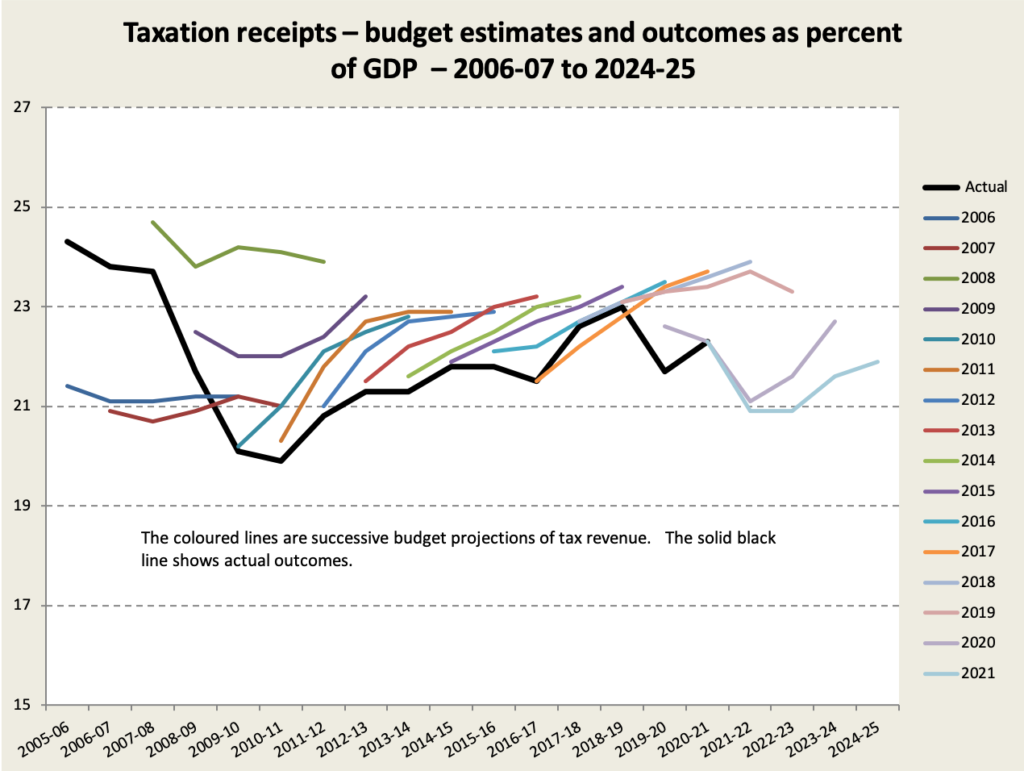
Albanese’s reply: “Labor is on your side”
Albanese’s reply to the budget was conservative in tone. Apart from a plan to invest substantially in public housing – an omission from the Coalition’s budget so obvious that he couldn’t not have announced it – it was light on anything that could be called a bold or transformative policy announcement. That is understandable, in light of the savage and dishonest attack Morrison made on Labor’s 2019 economic platform, in cooperation with Clive Palmer and his colleagues in the Murdoch media.
But he managed to differentiate Labor from the Coalition on two important bases.
One was his articulation of a post-pandemic path for Australia. While the Coalition’s policies are about dithering our way back to pre-pandemic mediocrity, Albanese sees an opportunity for industrial reconstruction.
The other was his emphasis on good government.
I understand the value and the power of good government.
and
The policies and decisions of good government can make all the difference. A good government, building a strong economy and a fair society, opens the door to education, to employment, to decent housing, to proper health care, and a better life.
To many that may seem like a statement of the obvious. Indeed it should be a basic principle of public administration, but it is a clear differentiation from the Liberal Party’s belief that government is simply an unproductive overhead, expressed in its platform “that businesses and individuals – not government – are the true creators of wealth and employment”.
The Coalition’s expansive budget is less about providing necessary services than about using the public sector as a convenient channel for a fiscal boost to a weak economy. Expect a return to austerity once it has served its purpose.
Albanese’s speech had the requisite criticisms of government failings (a pity he had only 30 minutes) but above all it was a statement of principles.
The pandemic’s progress
Australia – she’ll be right mate
“It is assumed that a population-wide vaccination program is likely to be in place by the end of 2021.”
That’s a quote from Budget Paper 1. The language is vague, and we don’t know its basis. Whose assumption – Scott Morrison’s, his spiritual adviser, the bloke he met at the Ettamogah Pub?
At present about 60 000 doses a day are being delivered. These are mainly AstraZeneca and mainly to Australians over 50, with the bulk of Pfizer (and now Moderna) mRNA vaccines to be available before the end of the year. Assuming all those 60 000 doses are for the 8.4 million Australians over 50, complete vaccination with two shots will take 280 days – well past the end of the year. And even if all promised mRNA doses arrive and can be geographically distributed, how will the remaining 12 million adults under 50 be delivered two doses in such a short time? The arithmetic doesn’t add up.
More credible, although still in passive voice, is the statement in the same budget paper “Inbound and outbound international travel is expected to remain low through to mid-2022, after which a gradual recovery in international tourism is assumed to occur”. That gives a better hint as to when the government expects some level of herd immunity to be achieved. Norman Swan, on Coronacast, suggests that this is a better indicationof when immunisation will be satisfactorily completed unless there is some late surge this year. (In that same session he cites research that suggests the chance of contracting coronavirus outdoors is vanishingly small.)
Yet the budget includes nothing for dedicated quarantine arrangements beyond those we already have. This is in spite of what is almost certainly yet another transmission inside hotel quarantine. Why should someone who has taken care to avoid infection while overseas be placed at risk on return to Australia? And is the Morrison Government oblivious to the risk imposed on the whole unprepared community when someone who reasonably believes he or she has been through a safe quarantine period, starts to move through the community.
The rest of the world
Again, it’s largely a story about India. Half of the world’s recorded cases last week were in India. Otherwise the world’s recorded case numbers are falling.
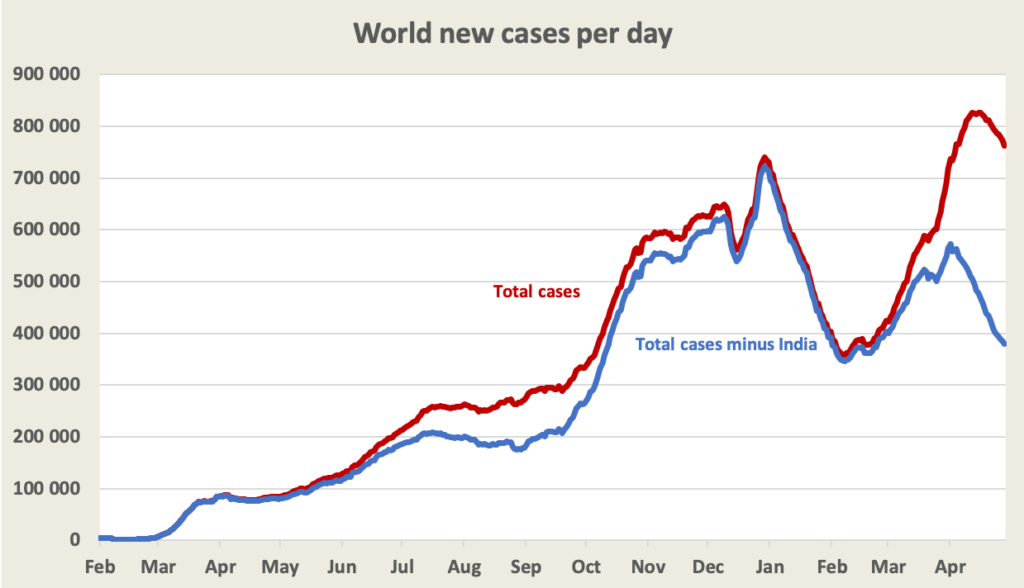
But as the virus spreads in poor countries with large populations, official estimates from the WHO and other sources are likely to underestimate by an increasing amount. The Economist this week reports that by examining excess deaths worldwide Covid-19 may have already claimed 7 to 13 million lives, directly or indirectly. That’s way in excess of the official 3 million estimate. On that basis The Economist calls for rich countries to release hoarded vaccine stocks and to ramp up production for distribution through COVAX. Lifting patents and intellectual property restrictions is a worthy idea, but because of cumbersome processes in the WTO, and difficulties in commissioning new plants, it is too slow a means to deal with the urgent problem of vaccinating the world. (Note that if you are not a subscriber to The Economist you will need to register with your E-mail address to have access to up to three articles a week.)
Recorded case numbers are still rising in many countries, and these are not necessarily the poorest ones: Japan, Greece and Denmark are among “developed” countries where cases rose last week.
So long as the world vaccination rate is low (by now 8.6 per cent of the population with one dose) there is no reason to expect the fall in case numbers to continue. And even if it does continue to decline, that decline will be an exponential decline: exponential functions are fast on the way up, slow on the way down.
Within Europe more countries – mainly small ones – are bringing their case numbers below 100 new cases per million population. In Malta, Portugal and the UK daily case numbers are all below 40 per million, but in the UK at least they seem to be flattening at that level. As is clear by now this virus does not reach an equilibrium: in the UK it may break out again, or re-commence its slow fall as more people are vaccinated. In the UK 53 per cent of the population has received a first dose, while 27 per cent are fully vaccinated.
India – privatisation and poor government
We are getting plenty of horror stories out of India’s experience with the pandemic – funeral pyres in Delhi, bodies in the Ganges, religious groups turning to way-out cures involving cow piss – scenes not unlike America’s at the height of their pandemic wave.
On Late Night Live Arundhati Roy explains the causes in clear terms: it’s about political failure – not only Modi’s neglect and failure to call a shutdown, but also his decisions to privatise so much of the health care system. (20 minutes.)
USA –the vaccination rate is slowing and dividing on partisan lines
In the USA case numbers are still high (120 daily cases per million population) but are falling. Vaccination rates are high: 46 per cent have received at least one dose, and 35 per cent of the population is fully vaccinated, but the rate of vaccination is slowing.
Writing in The Atlantic, staff writer Derek Thompson suggests three explanations for the slowdown. One is a set of cautionary reports (since rescinded) about rare adverse effects ofthe Johnson & Johnson vaccine – similar to reports about AstraZeneca. Another two explanations relate to the possibility that as vaccination progresses, vaccinators are coming up against the sceptics and antivaxxers. Thompson notes that vaccination reluctance is closely aligned with party alignment, there being far less vaccine hesitancy in Democrat-voting regions than in Republican-voting regions. (In Australia there are some partisan differences, with hesitancy and scepticism most strongly manifest among “other” voters.)
Vaccines – whose is the best?
In response to last week’s roundup, there was a lively set of comments relating to the comparative benefits of different vaccines. Certainly worth following. It’s important to remember that vaccines have to be considered on at least four criteria – safety, effectiveness in blocking the virus or providing symptomatic relief, protection against transmission, and ease of distribution. Also even a weak vaccine can be highly effective if a high rate of immunisation is achieved. With so many variables it is unlikely that any vaccine will dominate on all criteria.
Who’s to blame?
In 2017 there was a terrible fire in a block of apartments in London – the Grenfell Tower – in which 72 people died. It originated in a faulty refrigerator in one of the lower floors. The deaths resulted from a combination of negligence – flammable cladding, a poorly-equipped fire service, and the advice from incompetent bureaucrats who told residents to stay in their upper floors because all would be OK.
What does this have to do with Covid-19?
Almost everything. There was an original fault in both cases – the refrigerator fire and the outbreak in Wuhan were both preventable and containable but the fire and the virus spread from their sources. There was negligence at the source, but most blame, in both cases, falls on those who let the fire and virus spread.
That’s why Morrison’s invective against China, an echo of Trump’s calling Covid-19 the “China virus”, was so offensive and unhelpful. No one sheets all the blame for the Grenfell Tower disaster on the tenant with a shoddy refrigerator.
The Independent Panel for Pandemic Preparedness and Response has presented its findings and recommendations for action to curb Covid-19 and to ensure that any future infectious disease outbreak does not become another catastrophic pandemic. Its main message is about authorities ignoring clear warnings of an increasing rate of zoonotic disease. There is plenty of blame to go around: the Chinese authorities were too slow to react, but the overwhelming negligence was that “too many countries took a ‘wait and see’ approach rather than enacting an aggressive containment strategy that could have forestalled the global pandemic”. Its recommendations are on two levels – stronger international cooperation (the WHO needs to be better resourced and supported), and better preparedness by member governments.
The Panel was co-chaired by former New Zealand Prime Minister Helen Clark, and former Liberia President Ellen Johnson Sirleaf.
Sources
See our separate web page of hyperlinks to generally reliable information and analysis about Covid-19, including the ABC’s vaccine tracker. Norman Swan takes a diversion into influenza, putting forward ideas about why there have been so few cases. Maybe it’s to do with face masks, social distancing, not turning up to work when ill, but it is also to do with the way influenza travels and mutates. Less travel globally, less influenza. From the FluTracking site, a joint government-university venture, we can see how the flu virus has been suppressed in Australia. (They are seeking more volunteers to sign up.)
The New York Times Covid vaccine tracker has a world map of vaccination status. Africa so far has a very low rate of vaccination, while in Europe many countries have vaccinated around 40 per cent of their population. Otherwise there are no strong broad geographical patterns.
Foreign affairs
China
Drawing on the wisdom of George Kennan, the US diplomat who advocated containment of the Soviet Union during the Cold War, Kishore Mahbubani has words of good sense directed to those who are criticising China: Biden should summon the courage to reverse course on China.
In the Cold War, when America compared itself with the Soviet Union, it was clear that America was ahead on all criteria: the Soviet Union’s communist experiment had failed. But China in 2021 is not the Soviet Union in 1971, and America’s failings are on clear display to the world. Trump’s aggressive approach to China only strengthened Xi Jinping’s position: Biden should disown it and develop a better strategy.
(Mahbubani’s comments are about America: he does not mention small states making gratuitous provocations against China in attempts to boost their domestic political fortunes.)
Israel
Why has violence escalated in Israel and how can it be quelled?
On the ABC’s Breakfast program Sally Sara interviews Aaron David Miller of the Carnegie Endowment about the conflict. In spite of asymmetric casualties, Palestinians having lost many more lives than Israelis, Biden has refused to condemn Israel’s actions.
Miller explains the reasons for Biden’s policies (his priorities are domestic), how the conflict has escalated (both sides bear responsibility), and the prospects for an externally-mediated peace settlement (the US has no relationship with Hamas, but Egypt could play a role). (7 minutes.)
Europe
Last week all 27 members of the EU signed what is known as the Porto Declaration, committing member states to reducing social and economic inequalities. Notably, on the insistence of Poland, where there reigns a medieval version of Catholicism, gender equality did not make it into the final document.
But the declaration does commit countries to a “digital, green and fair transition” and to joint action on the pandemic. Declarations are easy to draft and easy to ignore, but they are a first step and can be held up to governments that are not abiding to what they have endorsed.
Public ideas
Capitalism died in 2008, but we didn’t notice
Speaking to a seminar in Jerusalem Yanis Varoufakis takes us through a short history of capitalism: Postcapitalism – its present, two possible futures & a story in between.
As Marx observed, capitalism unleashed extraordinary productive forces, but we now live in a postcapitalist world where the finance sector has taken over from the real economy – a takeover consolidated in 2008. Varoufakis describes how two crises – the Great Depression of the 1930s and the 2008 Global Financial Crisis – transformed capitalism as we had come to know it. He concludes with an idealised economic model – a market economy without capitalism. (Don’t worry if you don’t immediately follow it: the first 40 seconds of the 55-minute YouTube video is in Hebrew.)
Advice for progressives
The challenge of our day is “tailor-made for the progressive cause. It requires active government; a commitment to social justice and equality; an overhaul of public services, particularly health and education; measures to bring the marginalised into society’s mainstream; and a new 21st-century infrastructure”.
Writing in New Statesman Tony Blair asks why progressives fail to rise to this challenge: Without total change, Labour will die.
He is writing from the perspective of British Labour – a different party from our Labor Party in a country with a very different culture and economic structure – but his advice seems to hold for any party of the left. There are huge swathes of people, particularly the young, who are dissatisfied with parties of the right, but they aren’t finding a home in traditional social democratic parties. Blair believes they find these parties’ old shibboleths unattractive and are turned off by factions that have brought woke culture to their platforms. Social-democratic parties need a radical agenda – a radicalism that matches people’s values and that fits with the opportunities presented by new and emerging technologies.
Blair seems to have moved on from his insipid “third way” – a movement of compromises applying a little socialism here, a little free market there, lacking any connecting principles or “narrative”. It would appear that Australian Labor, however, hasn’t moved on from that half-hearted approach to public policy.
Stan Grant on religion, politics, identity
It is hard to summarise Andrew West’s discussion with Stan Grant on the ABC’s Religion and Ethics Report. Grant as a foreign correspondent has been to many places, such as the Afghanistan-Pakistan border region, where religious beliefs and long memories shape political movements. He clearly explains the strong beliefs and grievances that underpin movements such as the Taliban and ISIS. He covers the values that shape modern China, another place with historical grievances, held together by promises of prosperity, but with an underlying fragility as the old order has been swept aside.
Beyond the Middle East and China, he sees a worldwide struggle between liberalism and authoritarianism – authoritarianism is winning for now. He concludes with observations on secularism, identity and pluralism, including the challenging observation that we identify ourselves not by what we are but by what we are not. (31 minutes.)
Grant’s latest book is With the falling of the dusk: a chronicle of the world in crisis.
Polls and surveys
Per Capita tax survey
This year’s Per Capita Tax Survey is the broadest it has ever done, with responses to 32 sets of questions about taxes and public expenditure. As in other surveys health and education are Australians’ priorities for public spending.
It has revealing observations about people in high-income households. More than half of people in households with more than $200 000 income believe they pay too much tax. But a few tables further on a similar majority of people in the same households with more than $200 000 income believe that “high-income earners pay too little tax”.
Per Capita does not explain the reason for this apparent contradiction. It is possible that many people in such high-income households just don’t know how well-off they are; there is a body of research suggesting that most people consider their income and wealth to be about “average”. It is also possible that this perception results from developments such as private schools and socially-segregated urban regions: we have become the sort of country where we mix only with people who are similar to ourselves.
There is a set of questions relating to negative gearing and capital gains tax concessions. Responses show predictable but not strong partisan differences. On these questions they also reveal a significant proportion of “not sure/don’t know”. It appears that the reforms in these areas that Labor took to the 2019 election – reforms that were economically responsible and that would have helped those with low incomes – were not understood. Did Labor fail to explain them well enough – did it rely too much on the jargon of economics to explain these measures? Did the media, through incompetence or partisan bias, not present them properly? Did Morrison’s campaign of lies about Labor’s policies play into people’s financial ignorance and risk-aversion?
Unsurprisingly there is not much support for Stage 3 tax cuts, which would be of most benefit to those with very high incomes. And there is strong support for a higher rate of unemployment benefit.
One promising revelation is that while about 40 per cent of Australians believe that when compared to other “developed” countries Australia is a “high-taxing, big government country”, that is down from more than 50 per cent in 2017. The proportion who correctly believe that we are “a low taxing, small government country” is still less than 10 per cent, but is steadily rising. For a comparison with other high-income “developed” countries, see our roundup of April 24: our taxes are close to the lowest of high-income OECD countries.
The Australia Institute on taxes and civilisation
The Australia Institute has polled 1000 Australians on attitudes to tax and budget priorities.
A clear majority of us – 69 per cent – agree with Oliver Wendell Holmes’ statement that “taxes are what we pay for a civilized society”. Even 78 per cent of Coalition supporters agree with that statement. (So why does the Coalition keep conveying the impression that taxes are evil and that the public sector does nothing worthwhile?) Only “One Nation” and “Other” supporters seem to dislike taxes and civilisation.
On budget priorities “Spending on government services like health and education” comes out on top, well ahead of “income support for those seeking employment”, “tax cuts” and “decreasing the deficit”.
Essential – Morrison’s spin is paying dividends
The Essential Report has its monthly findings on our approval or otherwise of Morrison and Albanese and on our preferred prime minister. Albanese’s net approval continues to slide, and Morrison’s lead as preferred prime minister has widened. It’s as if the vaccine rollout has been handled competently, the government has developed a coherent energy policy, people’s real incomes are rising, housing has been kept affordable, the government is handling public administration competently and openly, and Morrison’s character is beyond reproach.Why?
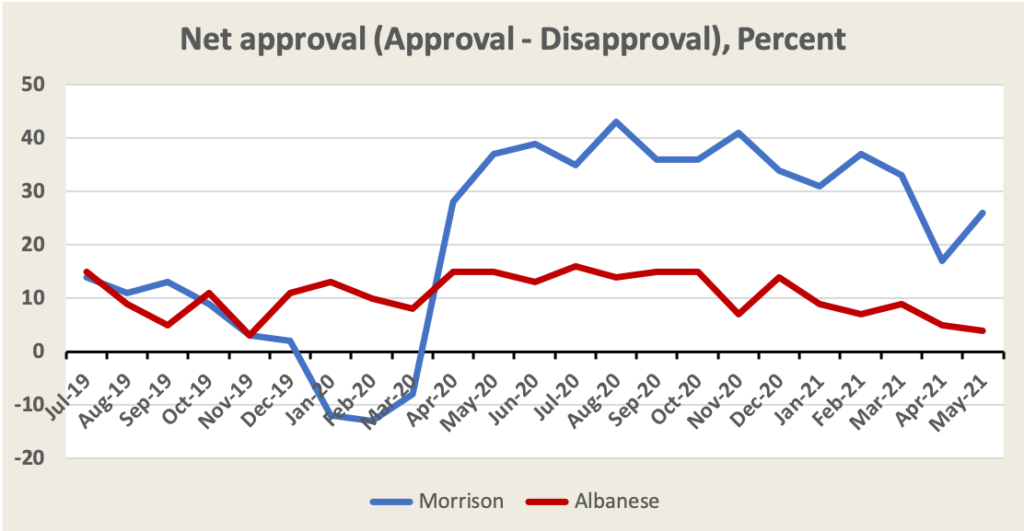
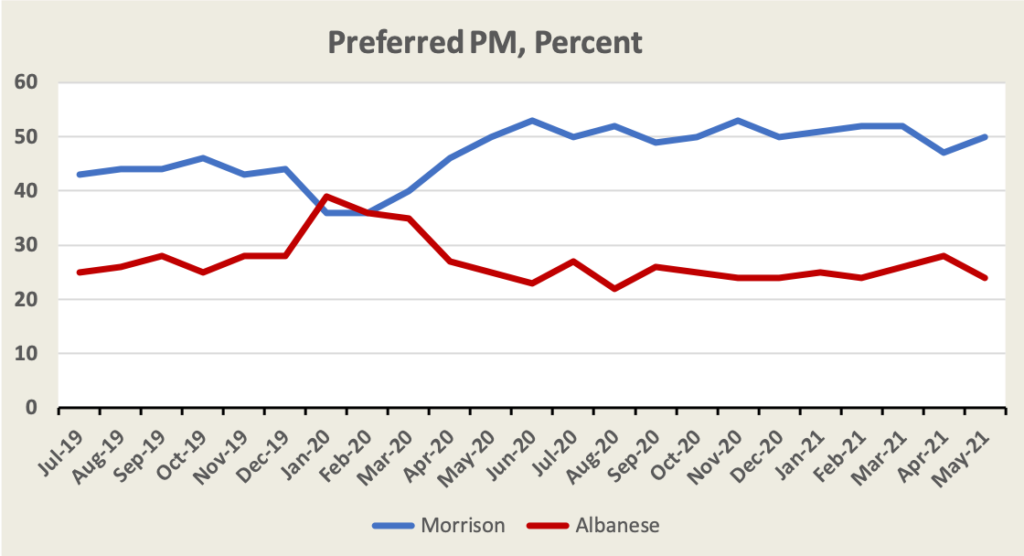
It has a set of questions on budget expectations (the survey was completed on May 10, just in time for a few pre-budget announcements). A majority expected the budget to be good for those who are well-off and for big-business. Increased funding for aged care, women’s safety, vaccine manufacture, small business support, early child education and care, and an energy transition from fossil fuels to renewables all ranked highly in people’s preferences.
A pair of questions was designed to draw out voters’ views on trickle-down economics. No one, not even Coalition supporters, seems to like it. No surprises there. Nor was there much enthusiasm for reducing the government’s fiscal debt.
When asked about which economic indicators are the most important, the unemployment rate and the cost of household bills came out on top. Tellingly, while “the cost of household bills” scored 20 per cent on this question, the “consumer price index” scored only 5 per cent. People’s concerns are not about rising prices. Rather they are about an ongoing squeeze between income and cost of living, a predictable outcome of five years of stagnant wages.
There were questions on attitudes to vaccination – not much change – and on the ban on people entering from India – inconclusive, with a spread of attitudes.
And there was a question about the possibility of a military conflict with China in the near future. Because the question was prompted with a quote from Dutton and the wording was vague, not too much can be read into its finding that 39 percent were concerned, 25 per cent were not concerned, and presumably 36 per cent were disengaged.
Liberals returned in Tasmania
Peter Gutwein’s Liberal Party has been returned in Tasmania with 13 seats in the 25-member parliament, elected in five divisions of five members on a proportional representation basis. Both the Liberals and Labor lost votes (Liberals down 1.5 per cent, Labor down 4.4 per cent), particularly in Hobart, while the Greens, independents and minor parties improved their vote. Overall there has been no change in parties’ parliamentary representation. (Tasmania is fortunate in not having a National Party.)
The ABC’s state political reporter Alexandra Humphries comments on the election: Tasmanian Liberals have returned to majority government, but it won't be smooth sailing. In Tasmania party loyalties are a little more fluid than in other states.
Webinars and events
Australia Institute webinars
Next Wednesday, May 19, at 11:00 AEST, Andrew Giles, Shadow Minister for Cities and Urban Infrastructure; and Holly Walker, Deputy Director of the Helen Clark Foundation will have a conversation about ending loneliness, a public health challenge exacerbated by the Covid-19 pandemic.
Another perspective on a troubled land
In 1999 Daniel Barenboim and Edward Said came together in Weimar to create the West-Eastern Divan Orchestra.
See **_Michael West Media_** for more analysis of these and other economic and political issues, and watch out for Peter Sainsbury’s Sunday environment round up.
